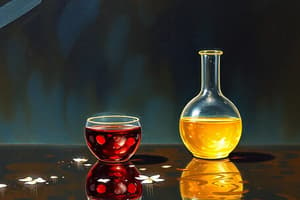Podcast
Questions and Answers
What does 'at equilibrium' mean in terms of reaction rates?
What does 'at equilibrium' mean in terms of reaction rates?
- Neither reaction occurs.
- The reverse reaction rate is greater than the forward reaction rate.
- The forward reaction rate is equal to the reverse reaction rate. (correct)
- The forward reaction rate is greater than the reverse reaction rate.
What occurs at equilibrium?
What occurs at equilibrium?
- Only the forward reaction occurs.
- Both the forward and reverse reactions continue. (correct)
- Only the reverse reaction occurs.
- Both the forward and reverse reactions stop.
At equilibrium, what can be said about the total amount of products and reactants?
At equilibrium, what can be said about the total amount of products and reactants?
The total amount of products may be equal to, greater than, or less than the total amount of the reactants.
The value of the equilibrium constant for a reaction changes with temperature.
The value of the equilibrium constant for a reaction changes with temperature.
What condition tends to lead reactions to run to completion?
What condition tends to lead reactions to run to completion?
How can a reaction system at equilibrium be made to run to completion?
How can a reaction system at equilibrium be made to run to completion?
In a chemical equilibrium expression, coefficients from the equation appear as exponents.
In a chemical equilibrium expression, coefficients from the equation appear as exponents.
What symbol represents the equilibrium constant?
What symbol represents the equilibrium constant?
What does a very high value of K indicate?
What does a very high value of K indicate?
What type of reaction is characterized by products that can react to re-form reactants?
What type of reaction is characterized by products that can react to re-form reactants?
The equilibrium constant depends on changes in temperature.
The equilibrium constant depends on changes in temperature.
What does a very low value of K indicate?
What does a very low value of K indicate?
Under suitable conditions, what proportion of all chemical reactions are reversible?
Under suitable conditions, what proportion of all chemical reactions are reversible?
For a given reaction at a given temperature, Keq will vary depending on the initial concentrations of the reactants and products.
For a given reaction at a given temperature, Keq will vary depending on the initial concentrations of the reactants and products.
A reaction is at equilibrium when the rate of the forward and reverse reactions are unequal.
A reaction is at equilibrium when the rate of the forward and reverse reactions are unequal.
When changes are made to a system at equilibrium, the system shifts to a new equilibrium position.
When changes are made to a system at equilibrium, the system shifts to a new equilibrium position.
Adjusting the concentrations of either the reactants or products in a reaction puts stress on the equilibrium.
Adjusting the concentrations of either the reactants or products in a reaction puts stress on the equilibrium.
In a closed system at equilibrium, the number of molecules changing from A to B is equal to the number changing from B to A.
In a closed system at equilibrium, the number of molecules changing from A to B is equal to the number changing from B to A.
At a particular temperature, an equilibrium system has only one value for Keq.
At a particular temperature, an equilibrium system has only one value for Keq.
A homogeneous equilibrium reaction has reactants and products that are not constant.
A homogeneous equilibrium reaction has reactants and products that are not constant.
At equilibrium, the concentrations of reactants and products are not constant.
At equilibrium, the concentrations of reactants and products are not constant.
The state of equilibrium is dynamic and not static.
The state of equilibrium is dynamic and not static.
The law of chemical equilibrium states that at a given temperature, a chemical system may reach a state in which a particular ratio of reactant and product concentrations has a constant value.
The law of chemical equilibrium states that at a given temperature, a chemical system may reach a state in which a particular ratio of reactant and product concentrations has a constant value.
Chemical equilibrium is described by an equilibrium constant expression that relates the concentrations of reactants and products.
Chemical equilibrium is described by an equilibrium constant expression that relates the concentrations of reactants and products.
The value of K is constant over a range of temperatures.
The value of K is constant over a range of temperatures.
A heterogeneous equilibrium reaction has reactants and products that are all in the same physical state.
A heterogeneous equilibrium reaction has reactants and products that are all in the same physical state.
When a reaction results in an almost complete conversion of reactants to products, chemists say that the reaction goes to completion.
When a reaction results in an almost complete conversion of reactants to products, chemists say that the reaction goes to completion.
A ____________ reaction is a chemical reaction that can occur in both the forward and reverse directions.
A ____________ reaction is a chemical reaction that can occur in both the forward and reverse directions.
What happens to a reaction at equilibrium when more reactant is added to the system?
What happens to a reaction at equilibrium when more reactant is added to the system?
In an endothermic reaction at equilibrium, what is the effect of raising the temperature?
In an endothermic reaction at equilibrium, what is the effect of raising the temperature?
In an equilibrium reaction that makes more moles of gas than it consumes, what is the effect of increasing the pressure?
In an equilibrium reaction that makes more moles of gas than it consumes, what is the effect of increasing the pressure?
If a reaction has an equilibrium constant just greater than 1, what type of reaction is it?
If a reaction has an equilibrium constant just greater than 1, what type of reaction is it?
Flashcards are hidden until you start studying
Study Notes
Equilibrium Concepts
- At equilibrium, the forward reaction rate equals the reverse reaction rate, indicating no net change in concentrations.
- Both forward and reverse reactions continue at equilibrium, maintaining a dynamic balance in the system.
Product and Reactant Relationships
- At equilibrium, the total amounts of products can be equal to, greater than, or less than that of reactants.
- The equilibrium constant (Keq) for a reaction is temperature-dependent and can vary with changes in temperature.
- A very high value of Keq indicates that products are favored, while a very low value suggests that reactants are favored.
Reaction Dynamics
- Gaseous products that escape from the reaction mixture often push reactions to completion.
- Removing a product from a system can drive a reaction at equilibrium towards completion.
- Under specific conditions, nearly all chemical reactions are reversible.
Equilibrium Constant and Chemical Reactions
- Coefficients from the balanced chemical equation appear as exponents in the equilibrium constant expression.
- For a particular reaction at a specific temperature, Keq has a single, constant value irrespective of initial concentrations of reactants and products.
Misconceptions and Clarifications
- The claim that a reaction is at equilibrium when the rates of forward and reverse reactions are unequal is false.
- Dynamic equilibrium means that while the concentrations of reactants and products remain constant, they are not static in nature.
- Adjusting reactant or product concentrations stresses the equilibrium, prompting the system to shift to a new equilibrium position.
Properties of Equilibrium Systems
- A homogenous equilibrium involves reactants and products in the same physical state, contrasting with heterogeneous equilibrium where they differ.
- The law of chemical equilibrium states a particular ratio of concentrations can maintain a constant value at a given temperature.
- The value of Keq does not remain constant across a range of temperatures.
Changes in System Conditions
- In an endothermic reaction, raising the temperature shifts the equilibrium toward the products, increasing product formation.
- Increasing pressure in reactions producing more moles of gas than consumed leads to a shift towards reactants.
Summary of Reversible Reactions
- A reversible reaction can occur in both the forward and reverse directions, allowing flexibility based on system conditions.
- When reactants are added to a system at equilibrium, the reaction compensates by producing more products.
Studying That Suits You
Use AI to generate personalized quizzes and flashcards to suit your learning preferences.




